Cube
2008/9 Schools Wikipedia Selection. Related subjects: Mathematics
| Regular Hexahedron | |
|---|---|
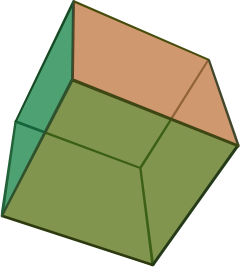 (Click here for rotating model) |
|
| Type | Platonic solid |
| Elements | F = 6, E = 12 V = 8 (χ = 2) |
| Faces by sides | 6{4} |
| Schläfli symbol | {4,3} |
| Wythoff symbol | 3 | 2 4 2 4 | 2 2 2 2 | |
| Coxeter-Dynkin | |
| Symmetry | Oh |
| References | U06, C18, W3 |
| Properties | Regular convex zonohedron |
| Dihedral angle | 90° |
 4.4.4 ( Vertex figure) |
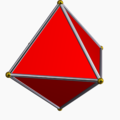 Octahedron ( dual polyhedron) |
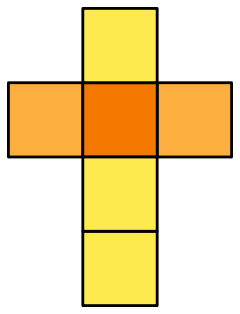 Net |
|
A cube is a three-dimensional solid object bounded by six square faces, facets or sides, with three meeting at each vertex. The cube can also be called a regular hexahedron and is one of the five Platonic solids. It is a special kind of square prism, of rectangular parallelepiped and of 3-sided trapezohedron. The cube is dual to the octahedron. It has cubical symmetry (also called octahedral symmetry). A cube is the three-dimensional case of the more general concept of a hypercube, which exists in any dimension.
Cartesian coordinates
For a cube centered at the origin, with edges parallel to the axes and with an edge length of 2, the Cartesian coordinates of the vertices are
- (±1,±1,±1)
while the interior consists of all points (x0, x1, x2) with -1 < xi < 1.
Formulas
For a cube of edge length a,
| surface area | 6a2 |
| volume | a3 |
| radius of circumscribed sphere |  |
| radius of sphere tangent to edges |  |
| radius of inscribed sphere |  |
As the volume of a cube is the third power of its sides a×a×a, third powers are called cubes, by analogy with squares and second powers.
A cube has the largest volume among cuboids (rectangular boxes) with a given surface area. Also, a cube has the largest volume among cuboids with the same total linear size (length + width + height).
Symmetry
The cube has 3 classes of symmetry, which can be represented by vertex-transitive coloring the faces. The highest octahedral symmetry Oh has all the faces the same colour. The dihedral symmetry D4h comes from the cube being a prism, with all four sides being the same colour. The lowest symmetry D2h is also a prismatic symmetry, with sides alternating colors, so there are three colors, paired by opposite sides. Each symmetry form has a different Wythoff symbol.
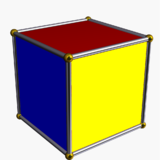 (3 colors) | 2 2 2 D2h |
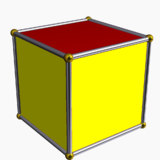 (2 colors) 4 2 | 2 D4h |
 (1 colour) 3 | 4 2 Oh |
Geometric relations

The cube is unique among the Platonic solids for being able to tile space regularly. It is also unique among the Platonic solids in having faces with an even number of sides and, consequently, it is the only member of that group that is a zonohedron (every face has point symmetry).
Other dimensions
The analogue of a cube in four-dimensional Euclidean space has a special name — a tesseract or (rarely) hypercube.
The analogue of the cube in n-dimensional Euclidean space is called a hypercube or n-dimensional cube or simply n-cube. It is also called a measure polytope.
There are analogues of the cube in lower dimensions too: a point in dimension 0, a segment in one dimension and a square in two dimensions.
Related polyhedra
The vertices of a cube can be grouped into two groups of four, each forming a regular tetrahedron. These two together form a regular compound, the stella octangula. The intersection of the two forms a regular octahedron. The symmetries of a regular tetrahedron correspond to those of a cube which map each tetrahedron to itself; the other symmetries of the cube map the two to each other.
One such regular tetrahedron has a volume of ⅓ of that of the cube. The remaining space consists of four equal irregular polyhedra with a volume of 1/6 of that of the cube, each.
The rectified cube is the cuboctahedron. If smaller corners are cut off we get a polyhedron with 6 octagonal faces and 8 triangular ones. In particular we can get regular octagons ( truncated cube). The rhombicuboctahedron is obtained by cutting off both corners and edges to the correct amount.
A cube can be inscribed in a dodecahedron so that each vertex of the cube is a vertex of the dodecahedron and each edge is a diagonal of one of the dodecahedron's faces; taking all such cubes gives rise to the regular compound of five cubes.
All but the last of the figures shown have the same symmetries as the cube (see octahedral symmetry).
Combinatorial cubes
A different kind of cube is the cube graph, which is the graph of vertices and edges of the geometrical cube. It is a special case of the hypercube graph.
An extension is the 3-dimensional k-ary Hamming graph, which for k = 2 is the cube graph. Graphs of this sort occur in the theory of parallel processing in computers.